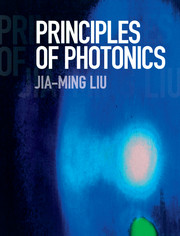Book contents
- Frontmatter
- Dedication
- Contents
- Preface
- Partial List of Symbols
- 1 Basic Concepts of Optical Fields
- 2 Optical Properties of Materials
- 3 Optical Wave Propagation
- 4 Optical Coupling
- 5 Optical Interference
- 6 Optical Resonance
- 7 Optical Absorption and Emission
- 8 Optical Amplification
- 9 Laser Oscillation
- 10 Optical Modulation
- 11 Photodetection
- Appendix A Symbols and Notations
- Appendix B SI Metric System
- Appendix C Fundamental Physical Constants
- Appendix D Fourier-Transform Relations
- Index
- References
9 - Laser Oscillation
Published online by Cambridge University Press: 05 August 2016
- Frontmatter
- Dedication
- Contents
- Preface
- Partial List of Symbols
- 1 Basic Concepts of Optical Fields
- 2 Optical Properties of Materials
- 3 Optical Wave Propagation
- 4 Optical Coupling
- 5 Optical Interference
- 6 Optical Resonance
- 7 Optical Absorption and Emission
- 8 Optical Amplification
- 9 Laser Oscillation
- 10 Optical Modulation
- 11 Photodetection
- Appendix A Symbols and Notations
- Appendix B SI Metric System
- Appendix C Fundamental Physical Constants
- Appendix D Fourier-Transform Relations
- Index
- References
Summary
CONDITIONS FOR LASER OSCILLATION
The word laser is the acronym of light amplification by stimulated emission of radiation. A medium that is pumped to population inversion has an optical gain to amplify an optical field through stimulated emission. Besides optical amplification, however, positive optical feedback is normally required for laser oscillation. This requirement is fulfilled by placing the gain medium in an optical resonator. One major characteristic of laser light is that it is highly collimated and is spatially and temporally coherent. The directionality of laser light is a direct consequence of the fact that laser oscillation takes place only along a longitudinal axis defined by the optical resonator. The spatial and temporal coherence results from the fact that a photon emitted by stimulated emission is coherent with the photon that induces the emission. The gain medium emits spontaneous photons in all directions, but only the radiation that propagates along the longitudinal axis within a small divergence angle defined by the resonator obtains sufficient regenerative amplification through stimulated emission to reach the threshold for oscillation. In order for the oscillating laser field to be most efficiently amplified in the longitudinal direction, any spontaneous photons emitted in a direction outside of that small angular range must not be allowed to compete for the gain. For this reason, a functional laser oscillator is necessarily an open cavity that provides optical feedback only along the longitudinal axis. Most of the randomly directed spontaneous photons quickly escape from the cavity through the open sides. Only a very small fraction of them that happen to be emitted within the divergence angle of the laser field mix with the coherent oscillating laser field to become the major incoherent noise source of the laser.
A laser is basically a coherent optical oscillator, and the basic function of an oscillator is to generate a coherent signal through resonant oscillation without an input signal. No external optical field is injected into the optical cavity for laser oscillation. The intracavity optical field has to grow from the field that is generated by spontaneous emission from the intracavity gain medium. When steady-state oscillation is reached, the coherent laser field at any given location inside the cavity has to be a constant of time in both phase and magnitude.
- Type
- Chapter
- Information
- Principles of Photonics , pp. 274 - 296Publisher: Cambridge University PressPrint publication year: 2016

